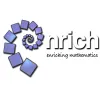Take a look inside 5 images
NRICH
Pros: The site's approach to problem-solving challenges kids to think mathematically, giving them the tools to do so.
Cons: Visual presentation needs to better adapt to its audience, with less text and easier "click" targets for younger kids in particular.
Bottom Line: It's an excellent classroom companion that can be implemented quickly with little adjustment and a high probability of success.
From their own student homepage, kids can choose to solve problems, check out trending math topics, or search for problems by collection or keyword, or from a list. Problems use text, video, and graphics, but kids will most often work offline with pencil and paper (problems can be printed). There are offline games for young kids to play, often with a partner. Kids at all grade levels can explore concepts via interactive online activities such as a peg board, Cuisenaire rods, modeling activities, or games.
Teacher homepages are also grouped by grade bands; you can visit them directly or through the Teacher Resources link that accompanies every problem.
NRICH is a website featuring activities to challenge and engage kids with math problems, games, and projects set in relevant contexts. The site is divided into four student homepages representing the "5 Key Stages," or grade bands within the British education system, and corresponding U.S. K-12 grade level info is available. Problems for younger kids involve numbers and operations, shape, position, data and measurement with algebra, geometry, trigonometry, and statistics (added as they get older). Problems are presented with text and some video, so there’s quite a bit of reading. They’re printable and can always be read aloud.
To access age-appropriate problems by topic, use the Other Resources link in the Collections box on any student or teacher homepage. Click Topics at the top of the page to access all of NRICH’s problems.
Other extras NRICH offers include:
• Online interactives that work on a whiteboard
• Offline games
• Projects that promote STEM education
• Articles about math for all grades
• Tips for preparing for college math
• Professional development for teachers
The "explore, question, notice, and discuss" approach is evident in the Getting Started suggestions link or in the problems themselves. The several solutions offered per problem highlight the relationship between creativity and math; it’s not just about the answer. Thorough corresponding teacher pages for each problem share possible approaches, questions to ask, and possible extensions to other support ideas. NRICH makes math a social activity, which is rare and fantastic. Kids will need to work away from the computer with pencil, paper, and other materials to sketch and model problems, but they don’t have to work alone. Have kids work in groups to submit a solution; NRICH always names the solver(s) of the solutions they accept. If small groups are not possible, kids can work alone or use the online community to find a partner.











